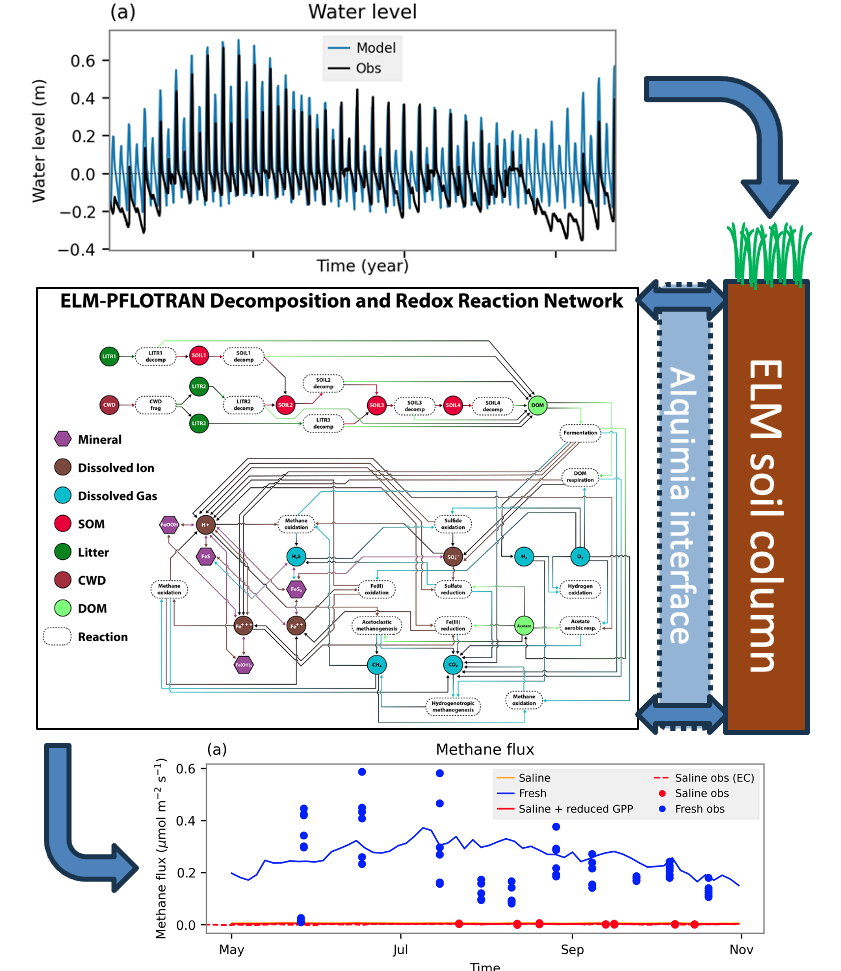Simulating Coastal Wetland Processes in the E3SM Land Model

Pexels: Photo by Tom Fisk on Pexels
Simulations of coastal ecosystems are made more accurate by directly incorporating tidal-driven biogeochemistry in a land surface model.
The Science
Coastal wetland carbon cycling and greenhouse gas production are strongly dependent on salinity and tidal influences. This study used a new model framework (Fig. 1) to simulate a network of biogeochemical reactions, including sulfur, carbon, and iron cycles, along with dynamic tidal hydrology and salt marsh vegetation directly within the land surface model component of the Energy Exascale Earth System Model (E3SM).
The Impact
Wetlands are hot spots of carbon storage and biogeochemical cycling due to salinity and tidal fluctuations, but current land models use simple decomposition frameworks that cannot directly resolve these biogeochemical influences. A new model framework allows complex biogeochemical reaction networks and their responses to tidal influences to be simulated directly in a full-featured land model. This results in more accurate process-based simulations of coastal wetland carbon cycling and greenhouse gas production.
Summary
Current land surface models, including the E3SM Land Model (ELM), lack process-based representation of the elemental interactions that drive wetland biogeochemistry. The researchers directly linked ELM to a flexible chemical reaction simulator, connecting organic matter decomposition with elemental cycles involving sulfur, iron, oxygen, and methane. They then simulated the impacts of tide-driven water level and salinity fluctuations on organic matter decomposition and greenhouse gas production in saline and freshwater tidal wetlands in Massachusetts, USA. The model predicted much lower methane emissions from saltwater-affected wetlands, which compared well to field measurements from coastal wetland sites. This model improves process-based simulations of carbon cycling and greenhouse gas production in wetland ecosystems, and the new capability of coupling complex reaction networks directly into a land surface model opens a broad range of possibilities for simulating subsurface biogeochemical interactions.
Publication
- Sulman, Benjamin N., Jiaze Wang, Sophie LaFond‐Hudson, Theresa A. O’Meara, Fengming Yuan, Sergi Molins, Glenn M Hammond, Inke Forbrich, Zoe G. Cardon, and Anne E Giblin. 2024. “Integrating Tide‐Driven Wetland Soil Redox And Biogeochemical Interactions Into A Land Surface Model”. Journal Of Advances In Modeling Earth Systems 16 (4). American Geophysical Union (AGU). doi:10.1029/2023ms004002.
Funding
- This work was supported by the Earth System Model Development program area of the Department of Energy, Office of Science, Biological and Environmental Research program, via the DOE Office of Science Early Career Research Program Award.
Contact
- Benjamin Sulman, Oak Ridge National Laboratory
This article is a part of the E3SM “Floating Points” Newsletter, to read the full Newsletter check:



